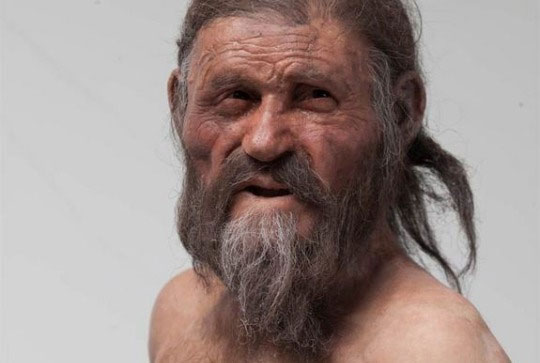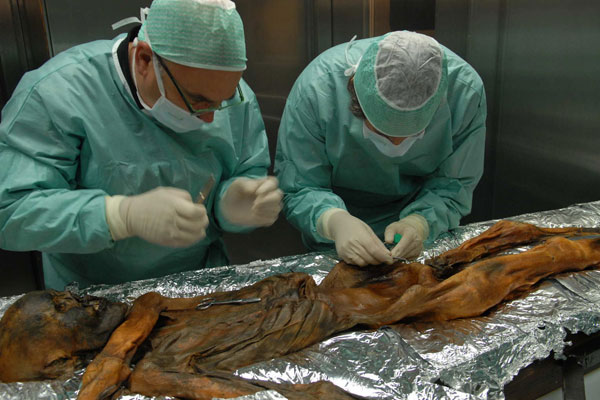Find the origin of the Iceman
The otzi band, the mummy of the Neolithic period was found in the Italian Alps in 1991, in fact a native of Central Europe and not the first generation of immigrants from Sardinia as thought. before. Genetically, Otzi is quite similar to other stone farmers across Europe.
The new discovery, released Thursday (November 8) at the American Society of Human Genetics, supports the theory that prehistoric farmers have expanded. the scope of migration from the Middle East to Finland, carrying their agricultural techniques.
Martin Sikora, a geneticist at Stanford University, said earlier this year scientists had been working on sequencing the Otzi gene sequence and found a surprising result: The iceman has a close relationship with Sardinians today rather than modern Central Europeans. In fact, however, experts have only studied part of the genome and therefore cannot solve the two basic questions: Are most Neolithic people in Central Europe having a special genetic profile? of Sardinians? and is the Otzi family emigrating from southern Europe?

A recent genetic analysis showed that the Otzi Tape is actually
is of Central European descent. (Photo: South Tyrol Archaeological Museum)
Otzi is one of the oldest and most well-preserved mummies in the world, having survived almost intact over the past 5,300 years. Up until now, no one could explain the situation as well as the life of this mummy.'Most likely Otzi is just a remote visitor to this Alps and his parents are Sardinians , ' Sikora said.
To answer this question, the Sikora group not only arranged the sequence of all Otzi genes but also compared it to the genes of four other target groups including (1) hundreds of modern Europeans, (2) one resident. Stone hunter-gatherers with the remaining bone fragments were found in Sweden, (3) a mummy 7000 years discovered in Iberia and (4) an Iron Age man found in Bulgaria.

The research team confirmed that although modern Sardinians are Otzi's closest relatives, in contrast to the prehistoric period, the Otzi gene is quite homogeneous to Bulgarian and Swedish farmers, while Swedish and Iberian residents are in the hunter-gatherers are like the Nordic people today. Thus, it is possible that former Middle Eastern to Northern European migrants brought their agriculture together with native hunter-gatherers, making the region's population increase.
At present, traces of ancient migrations in Europe have disappeared, however, the people of Sardinia today are still isolated from the outside world, thus retaining many genetic characteristics from the colonial population. The first Neolithic period, Sikora said.
This finding once again proves that agriculture plays an important role in shaping European ethnic groups, said Chris Gignoux, a geneticist at the University of California San Francisco.
Reference: Livesicence
- Find out the origin of a website
- Secretly decode thousands of years of mummies
- Find out the mysterious origin of the
- 61 tattoos were found on the mummy otzi band
- Find the origin of the blue rocks at Stonehenge?
- Find out the origin of giant rot flowers
- Unable to find a more reliable theory than Big Bang
- Find out the unexpected origin of the deer
- Detecting traces of origin forming groundwater on the surface of Mars
- The tape has a new look
- Explain the mystery of the 30 years of origin of superconductivity
- Genetic studies reveal the origin of the placenta
 'Fine laughs' - Scary and painful torture in ancient times
'Fine laughs' - Scary and painful torture in ancient times The sequence of numbers 142857 of the Egyptian pyramids is known as the strangest number in the world - Why?
The sequence of numbers 142857 of the Egyptian pyramids is known as the strangest number in the world - Why? History of the iron
History of the iron What is alum?
What is alum? 19 descendants of 5,300-year-old ice mummies were found
19 descendants of 5,300-year-old ice mummies were found  New cause of the death of the Otzi gang
New cause of the death of the Otzi gang  New discovery about the Otzi Tape
New discovery about the Otzi Tape  5,300-year-old ice-age people with Lyme disease
5,300-year-old ice-age people with Lyme disease  5000-year-old Otzi mummy and mysterious curse
5000-year-old Otzi mummy and mysterious curse  Decode the world's oldest tattoo on a 5,300-year-old mummy
Decode the world's oldest tattoo on a 5,300-year-old mummy 